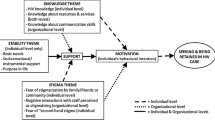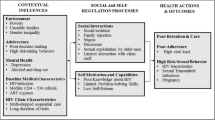Abstract
Adequate engagement in HIV care is necessary for the achievement of optimal health outcomes and for the reduction of HIV transmission. Positive Charge (PC) was a national HIV linkage and re-engagement in care program implemented by AIDS United. This study describes three PC programs, the characteristics of their participants, and the continuum of engagement in care for their participants. Eighty-eight percent of participants were engaged in care post PC enrollment. Sixty-nine percent were retained in care, and 46 % were virally suppressed at follow-up. Older participants were more likely to be engaged, retained, and virally suppressed. Differences by race and gender in HIV care and treatment varied across PC programs, reflecting the diverse target populations, locations, and strategies employed by the PC grantees. There is an urgent need for programs that promote HIV care and treatment among vulnerable populations, including young people living with HIV. There is also an urgent need for additional research to test the effectiveness of promising linkage and retention in care strategies, such as peer navigation.

Similar content being viewed by others
References
Centers for Disease Control and Prevention. HIV Surveillance Report, 2011; vol.23. http://www.cdc.gov/hiv/pdf/statistics_2011_HIV_Surveillance_Report_vol_23.pdf. Accessed 27 March 2014.
Hall HI, Frazier EL, Rhodes P, Holtgrave DR, Furlow-Parmley C, Tang T, et al. Differences in human immunodeficiency virus care and treatment among subpopulations in the United States. JAMA Intern Med. 2013;173(14):1337–44.
Gardner K. The continuum of care for persons with AIDS. QRB Qual Rev Bull. 1989;15(1):2–3.
White House Office of National AIDS Policy. National HIV/AIDS Strategy for the United States. Washington, DC: The White House: July 13, 2010. Available at http://www.whitehouse.gov/administration/eop/onap/nhas. Accessed 27 March 2014.
Barr D. Filling the Gaps in the U.S. HIV Treatment Cascade: Developing a Community-Driven Research Agenda: The Foundation for AIDS Research and Treatment Action Group. 2013. Available at http://www.treatmentactiongroup.org/hiv/filling-gaps. Accessed 12 December 2013.
Millett GA, Peterson JL, Flores SA, Hart TA, Jeffries WLT, Wilson PA, et al. Comparisons of disparities and risks of HIV infection in black and other men who have sex with men in Canada, UK, and USA: a meta-analysis. Lancet. 2012;380(9839):341–8.
Palella FJ Jr, Delaney KM, Moorman AC, Loveless MO, Fuhrer J, Satten GA, et al. Declining morbidity and mortality among patients with advanced human immunodeficiency virus infection. HIV Outpatient Study Investigators. N Engl J Med. 1998;338(13):853–60.
Mahungu TW, Rodger AJ, Johnson MA. HIV as a chronic disease. Clin Med. 2009;9(2):125–8.
Attia S, Egger M, Muller M, Zwahlen M, Low N. Sexual transmission of HIV according to viral load and antiretroviral therapy: systematic review and meta-analysis. AIDS. 2009;23(11):1397–404.
Bunnell R, Ekwaru JP, Solberg P, Wamai N, Bikaako-Kajura W, Were W, et al. Changes in sexual behavior and risk of HIV transmission after antiretroviral therapy and prevention interventions in rural Uganda. AIDS. 2006;20(1):85–92.
Del Romero J, Castilla J, Hernando V, Rodriguez C, Garcia S. Combined antiretroviral treatment and heterosexual transmission of HIV-1: cross sectional and prospective cohort study. BMJ. 2010;340:c2205.
Donnell D, Baeten JM, Kiarie J, Thomas KK, Stevens W, Cohen CR, et al. Heterosexual HIV-1 transmission after initiation of antiretroviral therapy: a prospective cohort analysis. Lancet. 2010;375(9731):2092–8.
Das M, Chu PL, Santos GM, Scheer S, Vittinghoff E, McFarland W, et al. Decreases in community viral load are accompanied by reductions in new HIV infections in San Francisco. PLoS One. 2010;5(6):e11068.
Gardner LI, Metsch LR, Anderson-Mahoney P, Loughlin AM, del Rio C, Strathdee S, et al. Efficacy of a brief case management intervention to link recently diagnosed HIV-infected persons to care. AIDS. 2005;19(4):423–31.
Liau A, Crepaz N, Lyles CM, Higa DH, Mullins MM, DeLuca J, et al. Interventions to promote linkage to and utilization of HIV medical care among HIV-diagnosed persons: a qualitative systematic review, 1996-2011. AIDS Behav. 2013;17(6):1941–62.
Higa DH, Marks G, Crepaz N, Liau A, Lyles CM. Interventions to improve retention in HIV primary care: a systematic review of U.S. studies. Curr HIV/AIDS Rep. 2012;9(4):313–25.
Craw JA, Gardner LI, Marks G, Rapp RC, Bosshart J, Duffus WA, et al. Brief strengths-based case management promotes entry into HIV medical care: results of the antiretroviral treatment access study-II. J Acquir Immune Defic Syndr. 2008;47(5):597–606.
Coleman SM, Rajabiun S, Cabral HJ, Bradford JB, Tobias CR. Sexual risk behavior and behavior change among persons newly diagnosed with HIV: the impact of targeted outreach interventions among hard-to-reach populations. AIDS Patient Care STDS. 2009;23(8):639–45.
Naar-King S, Bradford J, Coleman S, Green-Jones M, Cabral H, Tobias C. Retention in care of persons newly diagnosed with HIV: outcomes of the Outreach Initiative. AIDS Patient Care STDS. 2007;21(Suppl 1):S40–8.
Horberg MA, Aberg JA, Cheever LW, Renner P. O’Brien Kaleba E, Asch SM. Development of national and multiagency HIV care quality measures. Clin Infect Dis. 2010;51(6):732–8.
Kim JJ, Maulsby C, Kinsky S, Riordan M, Charles V, Jain K, et al. The development and implementation of the national evaluation strategy of access to care, a multi-site linkage to care initiative in the United States. AIDS Educ Prev. 2014;26(5):429–44.
Dean B, Debes, R, Bozzette, S, Buchacz, K, Brooks, JT. HIV laboratory tests used as a proxy for medical visits for defining engagement in care. Abstract No. 1036. Presented at 20th Conference on Retroviruses and Opportunistic Infections; March 3–6, 2013; Atlanta, GA.
U.S. Department of Health and Human Services. HAB HIV Performance Measures: Generally Asked Questions 2010. Available from http://hab.hrsa.gov/deliverhivaidscare/generalfaq.pdf. Accessed 14 March 2014.
Centers for Disease Control and Prevention. Vital signs: HIV prevention through care and treatment–United States. MMWR Morb Mortal Wkly Rep. 2011;60(47):1618–23.
Nosyk B, Montaner JS, Colley G, Lima VD, Chan K, Heath K, et al. The cascade of HIV care in British Columbia, Canada, 1996-2011: a population-based retrospective cohort study. Lancet Infect Dis. 2014;14(1):40–9.
Barros AJ, Hirakata VN. Alternatives for logistic regression in cross-sectional studies: an empirical comparison of models that directly estimate the prevalence ratio. BMC Med Res Methodol. 2003;20(3):21.
McNutt LA, Wu C, Xue X, Hafner JP. Estimating the relative risk in cohort studies and clinical trials of common outcomes. Am J Epidemiol. 2003;157(10):940–3.
Petersen MR, Deddens JA. A comparison of two methods for estimating prevalence ratios. BMC Med Res Methodol. 2008;8:9.
Gerstman B. Risk Ratios and Prevalence Ratios. Available at: http://www.sjsu.edu/faculty/gerstman/StatPrimer/ on 27 March 2014. Accessed 1 Oct 2013.
Hightow-Weidman LB, Jones K, Wohl AR, Futterman D, Outlaw A, Phillips G 2nd, et al. Early linkage and retention in care: findings from the outreach, linkage, and retention in care initiative among young men of color who have sex with men. AIDS Patient Care STDS. 2011;25(Suppl 1):S31–8.
Hightow-Weidman LB, Smith JC, Valera E, Matthews DD, Lyons P. Keeping them in “STYLE”: finding, linking, and retaining young HIV-positive black and Latino men who have sex with men in care. AIDS Patient Care STDS. 2011;25(1):37–45.
Gardner LI, Marks G, Metsch LR, Loughlin AM, O’Daniels C, del Rio C, et al. Psychological and behavioral correlates of entering care for HIV infection: the Antiretroviral Treatment Access Study (ARTAS). AIDS Patient Care STDS. 2007;21(6):418–25.
Mugavero MJ, Amico KR, Horn T, Thompson MA. The state of engagement in HIV care in the United States: from cascade to continuum to control. Clin Infect Dis. 2013;57(8):1164–71.
Eberhart MG, Yehia BR, Hillier A, Voytek CD, Blank MB, Frank I, et al. Behind the cascade: analyzing spatial patterns along the HIV care continuum. J Acquir Immune Defic Syndr. 2013;1(64 Suppl 1):S42–51.
Mangal JP, Rimland D, Marconi VC. The Continuum of HIV Care in a Veterans’ Affairs Clinic. AIDS Res Hum Retroviruses. 2014;30:409–15.
Miller WC, Lesko CR, Powers KA. The HIV care cascade: simple concept, complex realization. Sex Transm Dis. 2014;41(1):41–2.
Keller SC, Yehia BR, Eberhart MG, Brady KA. Accuracy of definitions for linkage to care in persons living with HIV. J Acquir Immune Defic Syndr. 2013;63(5):622–30.
Acknowledgments
The authors would like to express their gratitude to the PC intervention staff for their dedication and for the individuals who participated in the PC intervention. This evaluation Project is supported by a Grant from AIDS United to Johns Hopkins Bloomberg School of Public Health. The overall Positive Charge Project was supported by an unrestricted Grant from Bristol-Myers Squibb (BMS) to AIDS United. Johns Hopkins Bloomberg School of Public Health only had a relationship with AIDS United (not BMS). We would also like to acknowledge those whose who took time to review the manuscript. The findings and conclusions in this article are those of the authors and do not necessarily represent the views of AIDS United, Johns Hopkins Bloomberg School of Public Health, or the grantees of the Positive Charge initiative.
Author information
Authors and Affiliations
Consortia
Corresponding author
Additional information
The members of the PC Intervention Team are listed in Appendix.
Appendix
Appendix
Peter Messeri and Maiko Yomogida (Columbia University, New York City, New York); Goldie Komaie, Michael Rivers, Amy Johnson and Roman Buenrostro (AIDS Foundation of Chicago, Chicago, Illinois); and Sarah Chrestman and Karen Mason (Louisiana Public Health Institute, New Orleans, Louisiana).
Rights and permissions
About this article
Cite this article
Maulsby, C., The Positive Charge Intervention Team., Charles, V. et al. Positive Charge: Filling the Gaps in the U.S. HIV Continuum of Care. AIDS Behav 19, 2097–2107 (2015). https://doi.org/10.1007/s10461-015-1015-0
Published:
Issue Date:
DOI: https://doi.org/10.1007/s10461-015-1015-0




